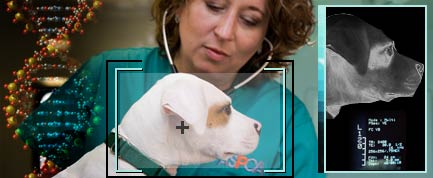Animal CSI: Horrendous Pet Crimes

Melinda Merck is a new breed of veterinarian.
In a 26-foot van equipped with state-of-the-art forensic tools, she travels to crime scenes throughout the country to assist law enforcement officials in their efforts to build cases against and prosecute animal cruelty offenders.
Merck is the only animal CSI specialist in the country.
She investigates about two cases each month that run the gamut from dog fighting and puppy mills to animal hoarding and bestiality.
“It’s applying all the forensic science that has traditionally been used on crimes against humans to animals,” Merck said of her job with the American Society for the Prevention of Cruelty to Animals (ASPCA) headquartered in New York City.
Federal agents sought her help last year in the Michael Vick dog fighting case where she exhumed 12 animal bodies and examined their remains. (A state case is still pending against Vick so she can’t discuss her findings.)
The most horrendous crime she investigated, though, involved two Atlanta teenagers who hog-tied a 3-month old puppy, poured paint on her and tried to light her on fire. When that didn’t work they put the pup in an oven and baked her to death. Then they showed the dead puppy to neighborhood children and threatened them not to tell.
Get the world’s most fascinating discoveries delivered straight to your inbox.
The young males, both with previous juvenile records — one for arson, the other for sexual assault — are now serving 10-year prison sentences.
Silent witnesses
Animal cruelty cases are difficult to prosecute because the victims can't talk or point out the abuser, so Merck must find solid evidence that won’t leave any doubts in the jurors’ minds. So far, she has succeeded. Of the 25 cases last year in which charges based on her work were pressed, she said, all were either won in trial or the suspects plead guilty.
Animal cruelty is often linked to other crimes, such as domestic violence, or indicates the perpetrator may commit future acts of violence against people.
“Time and time again we see that our nation’s most appalling criminals have a history of abusing animals,” said ASPCA president Ed Sayres.
For more than a decade Merck has studied and investigated animal cruelty cases while running a private veterinary practice in Georgia. But it wasn’t until joining the ASPCA last year that she began working in veterinary forensics full-time.
This new and emerging field is needed, she said, because crime scene examiners don’t have the knowledge of animals or animal behavior to correctly identify and interpret their findings.
They also don’t have the country’s first Mobile Animal Crime Scene Investigation Unit. The $220,000 vehicle, unveiled in December, allows Merck to process a crime scene more quickly and efficiently.
Maggots to DNA
The tools and tests at her disposal are the same ones used to investigate crimes against people. Merck analyzes blood splatter, examines bones for trauma and collects DNA samples. If maggots are present, she can accurately determine time of death or injury.
After scouring the area for evidence and examining animal victims, she works with investigators and prosecutors to develop the case and bring it to court.
For now, Merck’s the only animal CSI, but it won’t stay that way for long.
Veterinary schools have begun offering forensic classes. And the ASPCA plans to break ground this year on an anti-cruelty institute in New York City to provide training for veterinarians and law enforcement. It’s slated to open in 2010.
- Video: Dog Fighting
- Pet DNA Helps CSIs Take a Bite Out of Crime
- Vote For Your Favorite Pet
 Live Science Plus
Live Science Plus





